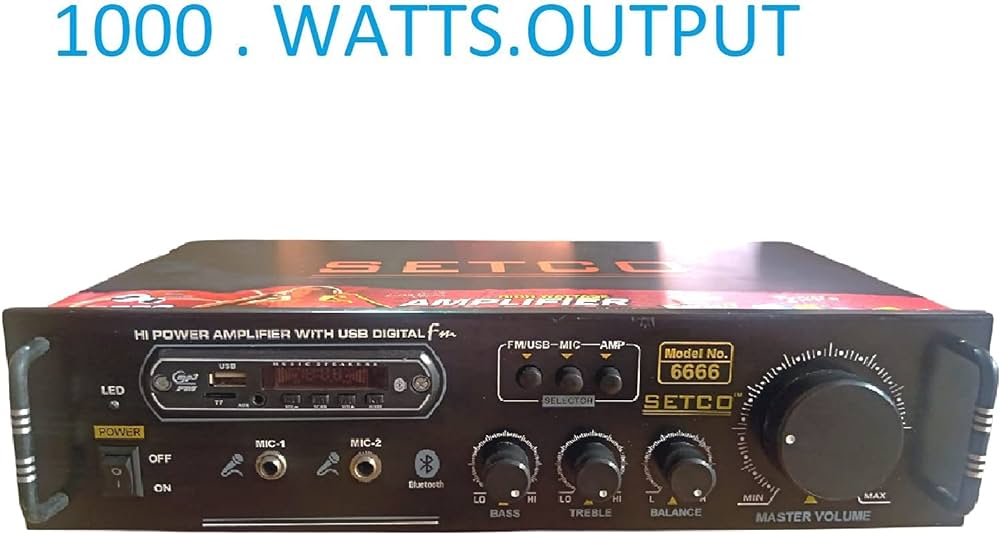Introduction:
Amplifiers: The Quiet Guardians of Sound
In the realm of audio equipment, there’s an unsung hero that often goes unnoticed, yet it plays an indispensable role in how we experience the music we love. Amplifiers, or “amps” as they are commonly known, are the backbone of any audio system, silently shaping and magnifying the sonic landscape that envelops our senses. While they might not grab headlines like the latest high-end headphones or cutting-edge streaming platforms, amplifiers are the workhorses that ensure our music reaches its full potential.
In this comprehensive guide, we’ll embark on a journey into the world of amplifiers. We’ll explore their history, the different types available, how they work, and their influence on the way we perceive sound. Whether you’re a casual music listener or an audio aficionado, understanding the importance of amplifiers will deepen your appreciation for the magic of music. So, let’s plug in and begin our exploration of these fascinating audio companions.
Chapter 1: The History of Amplifiers
To appreciate the significance of amplifiers, it’s crucial to delve into their history. The concept of amplification predates the electronic era, with early attempts involving mechanical devices, such as acoustic horns and megaphones. However, the real breakthrough came in the late 19th and early 20th centuries when vacuum tubes were introduced.
These tubes, characterized by their warm, glowing filaments, were the heart of amplification technology for many decades. They allowed for significant sound amplification and became essential in early radio broadcasting and audio equipment. The introduction of the transistor in the mid-20th century marked a seismic shift in amplifier technology, leading to the development of smaller, more efficient, and reliable amplifiers.
Chapter 2: Types of Amplifiers
Amplifiers come in various types, each designed for specific purposes and with unique characteristics. Let’s explore some of the most common types:
Stereo Amplifiers: These are the most familiar type of amplifiers, found in home audio systems. Stereo amplifiers have two channels, one for the left speaker and one for the right, and are designed to create a balanced, realistic soundstage.
Mono Block Amplifiers: In contrast to stereo amplifiers, mono block amplifiers have a single channel, making them ideal for powering a single speaker or a subwoofer. They provide the power needed for deep bass and impactful sound.
Integrated Amplifiers: These combine the amplifier and preamplifier functions into a single unit. Integrated amplifiers are space-efficient and often offer a range of inputs, making them suitable for use with various audio sources.
Tube Amplifiers: Tube amplifiers, also known as valve amplifiers, harken back to the early days of amplification. They are renowned for their warm, vintage sound and are prized by audiophiles for their unique sonic characteristics.
Solid-State Amplifiers: Modern solid-state amplifiers use semiconductor technology, such as transistors, to amplify the signal. They are known for their efficiency, durability, and compact design. Solid-state amplifiers are commonly used in a wide range of applications, from home audio systems to live sound reinforcement.
Digital Amplifiers (Class-D): Digital amplifiers, also known as Class-D amplifiers, use pulse-width modulation to amplify the audio signal. They are incredibly efficient, making them a popular choice for portable and battery-powered devices.
Chapter 3: How Amplifiers Work
At their core, amplifiers do precisely what their name suggests: they amplify an audio signal. But how do they achieve this? The basic operation of an amplifier involves several key components and processes:
Input Stage: The amplifier begins by receiving the audio signal from a source, which could be a turntable, CD player, or a digital music file.
Preamplification: In many cases, the incoming audio signal is weak, especially for vinyl records and passive microphones. The preamplification stage boosts the signal to a level suitable for amplification.
Amplification Stage: This is where the magic happens. The amplifier takes the preamplified signal and increases its voltage or current, resulting in a larger, more powerful signal. This stage is responsible for making the music audible and impactful.
Tone Control and Equalization: Some amplifiers include tone control circuits that allow you to adjust bass, midrange, and treble frequencies to fine-tune the sound to your liking. Equalization can compensate for the acoustics of your listening environment.
Output Stage: After amplification and any necessary adjustments, the amplified signal is sent to the output stage. Here, the signal is prepared to drive the speakers, whether they are cone-type drivers, horn-loaded speakers, or even headphones.
Protection Circuitry: Many modern amplifiers include protection circuitry to prevent damage to the amplifier or connected speakers. This may include features like overcurrent protection, overheat protection, and short-circuit protection.
Chapter 4: The Influence of Amplifiers on Sound
While amplifiers serve a fundamental purpose in audio systems, they also have a significant influence on the quality and character of the sound. This influence can be both subtle and profound, depending on the amplifier’s design, components, and the audio source. Here are some ways in which amplifiers shape our listening experience:
Tonal Characteristics: Different amplifiers can impart distinct tonal qualities to the sound. Tube amplifiers, for example, are known for their warm, harmonic-rich sound, while solid-state amplifiers often provide a cleaner and more neutral sound.
Dynamic Range: Amplifiers play a crucial role in expanding the dynamic range of audio. A high-quality amplifier can reproduce the softest whispers and the most thunderous explosions with clarity and precision.
Clarity and Transparency: The design and components of an amplifier impact its ability to faithfully reproduce the source audio. High-end amplifiers are engineered to provide maximum transparency, ensuring that the sound you hear is as close as possible to the original recording.
Power Handling: The power output of an amplifier is a critical factor in driving speakers. Insufficient power can result in distortion and clipping, while an overpowered amplifier can damage speakers. The right balance is essential for optimal performance.
Speaker Matching: The synergy between an amplifier and speakers is vital. Different speakers have varying impedance and sensitivity, and selecting the right amplifier to match your speakers can significantly impact sound quality.
Chapter 5: Choosing the Right Amplifier
Selecting the right amplifier for your audio setup can be a daunting task, given the wide range of options available. Here are some key factors to consider:
Audio Source: Consider the source components in your system, such as CD players, turntables, or digital devices, and ensure that the amplifier you choose has the necessary inputs to accommodate them.
Power Requirements: Determine the power requirements of your speakers. Make sure the amplifier can deliver sufficient power to drive your speakers without distortion.
Room Size and Acoustics: The size and acoustics of your listening room can influence the choice of amplifier. Larger rooms may require more powerful amplifiers to fill the space with sound.
Tonal Preferences: Think about your tonal preferences. Do you prefer the warmth of tube amplifiers, or do you lean towards the transparency of solid-state amplifiers?
Budget: Amplifiers come in a wide price range, from budget-friendly options to high-end models. Set a budget that aligns with your priorities and explore amplifiers within that range.
Brand and Reputation: Research the reputation of amplifier brands and models. Reviews and user experiences can provide valuable insights into the performance and reliability of a particular amplifier.
Chapter 6: The Future of Amplification
The world of audio equipment is constantly evolving, and amplifiers are no exception. Advancements in technology continue to shape the future of amplification. Here are some trends to keep an eye on:
Digital Amplifiers: Digital amplifiers, particularly Class-D, are becoming increasingly popular due to their energy efficiency and compact size. Expect to see more innovations in digital amplification technology.
Wireless and Networked Amplifiers: With the rise of smart home technology, amplifiers are becoming more integrated into networked audio systems, allowing for wireless streaming and control.
Eco-Friendly Design: As environmental concerns grow, expect to see more energy-efficient and eco-friendly amplifier designs that reduce power consumption and heat generation.
Customization and Personalization: Some amplifiers offer the ability to tailor the sound to individual preferences. We can anticipate further developments in customization features.
Conclusion: The Amplifier’s Ongoing Legacy
Amplifiers may not be the most glamorous part of your audio setup, but they are undoubtedly the backbone of your sound system. They silently amplify the music, making it more vibrant and lifelike, and in some cases, they even add their unique signature to the audio.
As we’ve explored in this guide, amplifiers have a rich history, come in various types, and play a critical role in shaping the way we perceive sound. Understanding the impact of amplifiers on your listening experience empowers you to make informed decisions when choosing audio equipment.
So, the next time you listen to your favorite song or immerse yourself in a movie, take a moment to appreciate the unsung heroes of the audio world—the amplifiers that faithfully bring your music to life.




